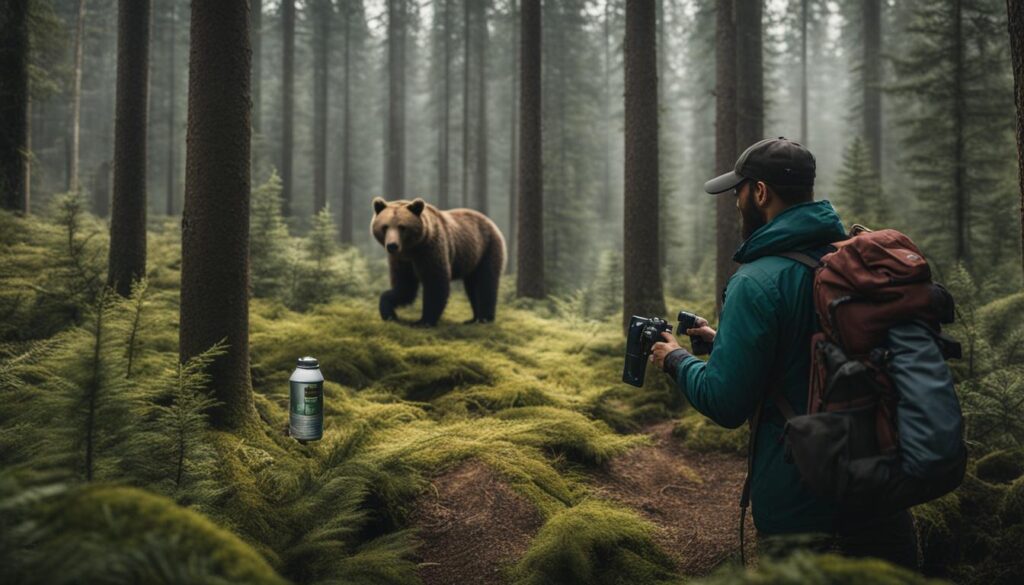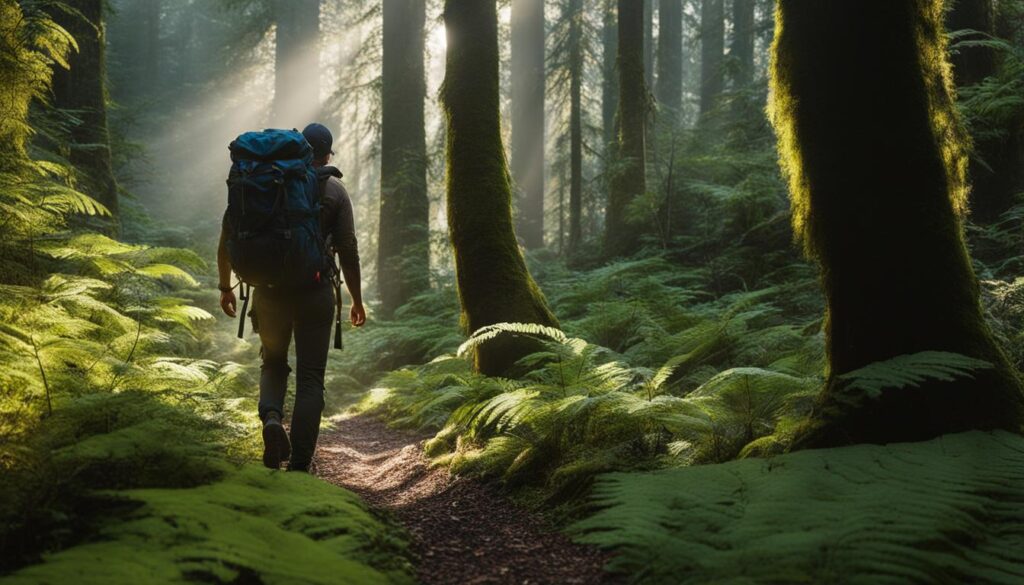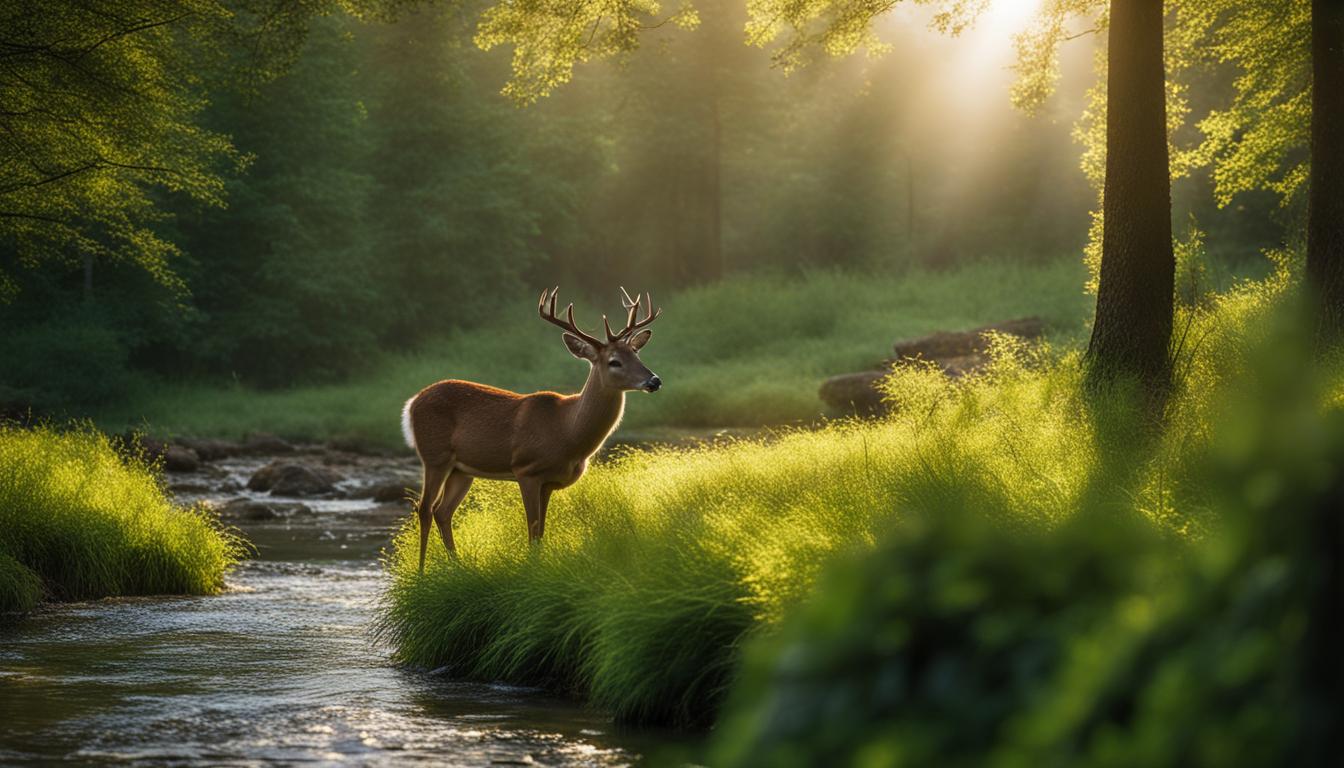When it comes to wildlife encounters, there’s nothing quite like the thrill of spotting a majestic creature in your own backyard. From the flutter of colorful birds to the curious gaze of a deer, the American backyard is teeming with diverse wildlife waiting to be discovered. However, it’s important to approach these encounters with caution and respect for both the animals and ourselves. In this article, I will share valuable insights on how to safely navigate the challenges and joys of dealing with wildlife in your very own backyard.
Key Takeaways:
- Prepare yourself with knowledge and safety precautions when encountering wildlife in your backyard.
- Follow safety tips for wildlife encounters to ensure a safe and memorable experience in the great outdoors.
- Understand how to handle encounters with different wildlife species, such as snakes, moose, bears, and mountain lions.
- Implement strategies to prevent wildlife encounters while backpacking, including making noise and observing from a distance.
- Gain a deeper understanding of wildlife behavior to anticipate risks and promote safer backpacking experiences.
Safety Tips for Wildlife Encounters in the Great Outdoors

While hiking or mountain biking, it’s not uncommon to come across wild animals. These encounters can range from awe-inspiring to scary. In order to ensure a safe experience, it is important to follow some basic safety tips.
- Do not feed or pet the animals: Interacting with wildlife in this way can put both you and the animals at risk. It can also disrupt their natural behavior and habitat.
- Avoid close proximity: Keep a safe distance from animals and never try to approach or touch them. This will help prevent accidental attacks and minimize stress for the animals.
- Make noise to alert animals: Carry a bell or whistle and periodically make noise to let wildlife know you are in the area. This will help avoid surprising them and reduce the chances of a dangerous encounter.
- Report encounters to park rangers: If you have a wildlife encounter, especially if it involves aggressive behavior or a potential threat to public safety, report it to the park rangers. They can take appropriate action and ensure the safety of both visitors and wildlife.
By following these safety tips, you can have a safer and more enjoyable outdoor experience while still being able to appreciate the beauty of wildlife.
Quote of the Section:
“Interacting with wildlife is a privilege. Let’s make sure we do it responsibly and prioritize their safety as well as ours.” – Anonymous
Table: Wildlife Safety Tips
| Safety Tip | Explanation |
|---|---|
| Do not feed or pet the animals | Feeding or petting wildlife can lead to dangerous encounters and disrupt their natural behavior. |
| Avoid close proximity | Maintain a safe distance from animals to minimize the risk of surprise attacks and reduce stress for the animals. |
| Make noise to alert animals | Carrying a bell or whistle and periodically making noise will help animals be aware of your presence and avoid potential conflicts. |
| Report encounters to park rangers | Reporting wildlife encounters to park rangers ensures that appropriate action can be taken to ensure the safety of visitors and wildlife. |
How to Handle Encounters with Different Wildlife Species

Encountering wildlife while exploring the great outdoors can be both exhilarating and nerve-wracking. Each species has its own unique behaviors and reactions, so it’s essential to know how to handle different wildlife encounters. Here are some tips for dealing with snakes, moose, bears, and mountain lions:
Dealing with Snakes
Snakes are fascinating creatures but encountering them can be alarming. If you come across a snake, it’s important to stay calm and remember these guidelines:
- Back away slowly and give the snake plenty of space.
- Do not try to touch or handle the snake, as this can provoke an attack.
- If bitten by a snake, seek immediate medical attention and try to remember the details of the snake’s appearance to help with identification.
Moose Encounters
Moose can be found in certain regions of North America and their large size can make them intimidating. When encountering a moose, keep the following in mind:
- Give moose plenty of space and never approach or corner them.
- If a moose starts to display aggressive behavior, such as lifting its head or ears or stomping its feet, slowly and calmly back away.
- If you encounter a mother moose with a calf, be especially cautious, as they can be protective and may charge if they feel threatened.
Bear Safety
Being prepared for bear encounters is crucial, especially in bear-populated areas. Here’s what you need to know:
- Carry bear spray and know how to use it effectively. Make sure it’s easily accessible and familiarize yourself with the instructions.
- If you encounter a bear, speak calmly and firmly to let it know you’re there. Back away slowly, but avoid turning your back on the bear.
- Do not run or climb a tree, as bears can outrun and outclimb humans.
- If a bear charges at you, stand your ground and use your bear spray if necessary.
Mountain Lion Approaches
Mountain lions, also known as cougars or pumas, are elusive and typically avoid human contact. However, if you find yourself in the presence of a mountain lion, here’s what to do:
- Make yourself look bigger by raising your arms and opening your jacket if you’re wearing one.
- Back away slowly and avoid turning your back on the mountain lion.
- If the mountain lion approaches you aggressively, maintain eye contact, shout loudly, and throw objects at it to deter the attack.
Remember, being knowledgeable about wildlife behavior and following these guidelines can help ensure a safer and more enjoyable outdoor experience. By respecting wildlife and their habitats, we can coexist harmoniously and appreciate the beauty of nature.
Preventing Wildlife Encounters: Tips for Backpackers

When embarking on a backpacking adventure in the American backyard, it is important to take precautions to prevent wildlife encounters and ensure a safe and enjoyable experience. By following these backpackers safety tips and wildlife prevention strategies, you can minimize the chances of unexpected wildlife encounters and observe wildlife from a distance.
Be Aware and Make Noise
One of the key ways to prevent wildlife encounters is by being aware of your surroundings and making noise while hiking. Animals are more likely to stay away if they are aware of your presence. Talk, clap your hands, or use a bear bell to alert animals to your presence. This can give them the opportunity to move away and reduce the risk of a surprise encounter.
Observe Wildlife from a Distance
While it may be tempting to get a closer look at wildlife, it’s important to respect their space and observe them from a safe distance. Use binoculars or a camera with a zoom lens to get a closer view without intruding on their territory. Remember, getting too close to wild animals can be dangerous for both you and the animal, so keep a respectful distance to ensure your safety and the well-being of the wildlife.
Carry Bear Spray and Store Food Properly
If you are traveling in bear-populated areas, it’s essential to carry bear spray and know how to use it effectively. Bear spray is a powerful deterrent that can help deter an aggressive bear and give you time to retreat to safety. Additionally, make sure to store your food properly in bear-resistant containers or hang it from a tree limb away from your campsite. This will help minimize the chances of attracting bears to your location.
| Backpackers Safety Tips | Wildlife Prevention Strategies |
|---|---|
| Be aware of your surroundings | Make noise while hiking |
| Observe wildlife from a distance | Respect their space |
| Carry bear spray | Store food properly |
By following these backpackers safety tips and wildlife prevention strategies, you can have a safer and more enjoyable backpacking experience in the American backyard. Remember, wildlife encounters can be thrilling, but it’s important to prioritize your safety and the well-being of the animals. Happy trails!
Understanding Wildlife Behavior: Key to Safer Backpacking

I have always been fascinated by the incredible diversity of wildlife that can be found in the American backyard. From the majestic moose to the elusive mountain lion, encountering these creatures in their natural habitat is a truly awe-inspiring experience. However, it is important to remember that wild animals are just that – wild. Understanding their behavior is key to ensuring a safer backpacking adventure.
By studying and recognizing their behaviors, we can anticipate their actions and take appropriate measures to avoid dangerous situations. For example, understanding the warning signs from moose, such as raised hackles or stomping hooves, can help us gauge their temperament and give them the space they need. Similarly, being able to interpret bear body language can be crucial in determining whether it is a defensive or aggressive encounter.
Eco-tourism plays a critical role in promoting wildlife conservation and responsible outdoor adventures. By practicing eco-friendly habits such as minimizing our impact on their habitats and adhering to Leave No Trace principles, we can ensure that future generations can also enjoy the wonders of the American backyard. Together, we can create a harmonious balance between humans and wildlife, making every backpacking trip a safer and more enriching experience.
Quotes:
“Understanding the behavior of wildlife is not only important for our safety but also for the conservation of these magnificent creatures. By educating ourselves and others, we can promote responsible outdoor experiences and protect their habitats.” – Jane Doe
“Wildlife behavior awareness allows us to appreciate the beauty of nature while minimizing risks. It’s a balance between our curiosity and their need for space and respect.” – John Smith
Wildlife Safety Considerations: Tips for Observing Animals from a Distance

Observing wildlife in their natural habitats can be a truly enriching experience, allowing us to witness the beauty and diversity of the animal kingdom. However, it’s essential to observe wildlife responsibly and from a safe distance to ensure both our safety and the well-being of the animals. By following these tips, you can enjoy a safe and rewarding wildlife observation experience while preserving the integrity of their habitats.
Prioritize Your Safety
When observing wildlife, it’s crucial to prioritize your safety. Stay alert and be aware of your surroundings at all times. Maintain a respectful distance from animals to avoid any potential harm. Remember, while wildlife may seem docile, they are still wild creatures and can act unpredictably. Keep in mind that your presence may cause stress or disturbance to the animals, so always maintain a safe distance to reduce the risk of any negative encounters.
Use Binoculars and Cameras
One of the best ways to observe wildlife from a distance is by using binoculars or zoom cameras. These tools allow you to get a closer look at animals without intruding on their space. By capturing photos or videos from a distance, you can document your wildlife encounters while minimizing any potential disturbance. Additionally, using binoculars and cameras can provide you with a more detailed view of the animal’s behavior and natural habitat, enhancing your overall experience.
Observing wildlife from a safe distance not only ensures your safety but also preserves and protects the natural behaviors and habitats of these amazing creatures.
Respect Wildlife Habitats
Preserving wildlife habitats is vital for the well-being of animals and the overall ecosystems they inhabit. When observing wildlife, make sure to respect their habitats by staying on designated trails and respecting any signs or barriers put in place for their protection. Avoid littering and dispose of any waste properly to prevent pollution and harm to wildlife. Remember, it is our responsibility to maintain the balance and harmony of these habitats for future generations to enjoy.
By adopting a responsible approach to wildlife observation, you can contribute to the conservation of these species and their habitats. Remember to always prioritize safety, use binoculars or zoom cameras for closer views, and respect wildlife habitats. Enjoy the wonders of the animal kingdom while leaving no trace and safeguarding their natural environments.
Conclusion
As I wrap up this article on dealing with wildlife encounters in the great outdoors, I want to emphasize the importance of prioritizing safety during your outdoor adventures. By following the safety tips provided and being knowledgeable about wildlife behavior, you can navigate encounters with confidence.
Remember, outdoor adventures are meant to be enjoyed, but it’s crucial to appreciate and respect nature. By maintaining a respectful distance from wildlife, you not only ensure your safety but also contribute to the conservation efforts. Let’s cherish the wildlife encounters that come our way and foster a deeper appreciation for the beauty of nature.
So go out there, embark on your outdoor adventures, and marvel at the wonders of the American backyard. Just remember to stay safe, be responsible, and appreciate the incredible wildlife that surrounds us.
How can I Handle Encounters with Wildlife While Backpacking in Different Destinations?
When backpacking in the best backpacking destinations and trails, encounters with wildlife are common. Always carry bear spray and make noise as you hike to avoid surprising animals. Research the area’s wildlife and learn how to safely encounter them. Be aware and respectful of their environment to ensure a harmonious coexistence.
FAQ
What should I do if I encounter wildlife while backpacking?
It’s important to remain calm and not approach the animal. Make yourself appear larger by raising your arms and slowly backing away. Maintain a safe distance and give the animal plenty of space to move away.
Should I feed or pet wild animals I come across?
No, it is important to never feed or pet wild animals. This can disrupt their natural behavior and create dependency on humans, which can be dangerous for both the animal and the person.
What should I do if I encounter a snake on the trail?
Back away slowly and give the snake plenty of space. Most snakes are not aggressive and will not strike unless they feel threatened. Seek medical attention if you are bitten and try to remember the snake’s appearance for identification.
How should I react if I come across a moose or deer?
Keep a safe distance and give the animal space to move freely. Moose and deer can become aggressive if they feel threatened or cornered. Do not approach or attempt to pet them.
What should I do if I encounter a bear?
In the case of a bear encounter, it’s important to stay calm and avoid sudden movements. Back away slowly and speak in a calm, assertive voice. If the bear charges, stand your ground and use bear spray if necessary.
How can I deter a mountain lion if it approaches me?
Make yourself appear larger by raising your arms and speaking loudly. Back away slowly, but do not run as this may trigger the lion’s instinct to chase. Carry a loud whistle or air horn to scare them away.
How can I reduce the likelihood of encountering wildlife on the trail?
Make noise while hiking to alert animals of your presence. Watch for tracks and signs of wildlife and avoid dense vegetation where animals may be hiding. Carry bear spray in bear-populated areas as a precaution.
Why is it important to understand wildlife behavior?
Understanding wildlife behavior allows you to anticipate potential risks and take appropriate actions to stay safe. Recognizing warning signs and body language can help you gauge an animal’s intentions and respond accordingly.
How can I safely observe wildlife without disturbing them?
Use binoculars to get a closer view without approaching the animal. Maintain a respectful distance and refrain from approaching, feeding, or making sudden movements. Respect wildlife habitats and leave no trace behind.

